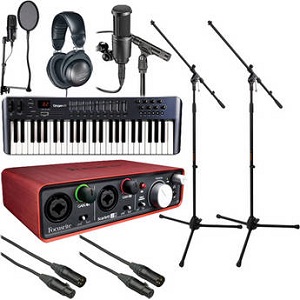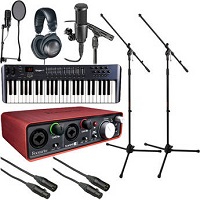
Recently I announced the creation of the Home Recording Starter Kit, which was a bundle of essential recording equipment put together in coordination with B&H Photo-Video-Audio. It is composed of the minimum gear needed at the lowest price to allow anyone to start recording professional audio on their computer. That first bundle – priced at $261.95 – is good for anyone, but especially suited to those doing mostly voice over recording, including video narration, podcasts, etc.
Now I want to tell you about another starter bundle aimed at musicians, also assembled by B&H to my specifications.
These bundles are great because they save you lots of time and money. For instance, the items in the new musicians bundle, if purchased individually, would cost a total of $529.79. And then there is the shipping. But the kit only costs $429.99, you save about a hundred bucks for the gear, and B&H offers free shipping (in the US). How cool is that?
So here is that second bundle, which is more geared (no pun intended) toward musicians – The Focusrite Home Recording Musicians Starter Kit. The primary differences are the addition of an extra microphone for recording acoustic guitar and other instruments, and a MIDI keyboard for playing virtual instruments. Of course there are two mic cables and stands, and the interface accepts two microphones simultaneously. Below are the details:
 The Home Recording Musician’s Starter Bundle ($449.95)
The Home Recording Musician’s Starter Bundle ($449.95)
- Focusrite Scarlett 2i2 USB Audio Interface
- Audio-Technica AT2041SP Cardioid Condenser Studio Microphone Package (includes 2 studio condenser mics: the AT2020 for vocals and the AT2021 small-diaphragm condenser for instruments)
- 2 xKopul Studio Elite 4000 Series 3-Pin XLR Male to 3-Pin XLR Female Audio Cable (10′)
- 2 x Auray Tripod-Boom Mic Stand
- Audio-Technica ATH-M20 – Closed-Back Headphone
- Auray Nylon Round Pop Filter with Gooseneck (6.6″)
- M-Audio Oxygen 49 -USB MIDI Controller
I already own two microphone stands, earphones, and one good microphone. I see that the midi keyboard in your advertisesment has only four octaves. I I intend to record keyboard and brass insturments since I play them. I have several very good, but aging speakers, Jim Lansing, ect. I would like to be able to use them. Would I need a stereo amplifier for that? I need a more comprehensive understanding of the set up. IO woul very much appreciate your gelp in setting up my recording station. Incidentally, I have a DMA in Composition, but y recording experience goes back to tape recorders (a Teac four track and a Revox). PJ
Paul – I started multitrack recording (if you don’t count bouncing cassette tapes on boom boxes:-P) with a Tascam 4-track cassette recorder too!
Let me try to answer your question. If you play piano/keyboards, then you will probably want to use a full-sized keyboard with MIDI capability. The reason I have the small keyboard in the musicians starter kit is mainly for the many things you can do with it – trigger virtual instruments being chief among them. I use mine for all kinds of instruments, especially drums. But also for orchestral instruments like string sections, synth pads, etc. My main instrument is guitar, not piano. So it’s OK. But I compose on a full-sized digital piano, which is why I think you’ll want to as well.
As for the speakers, the object – especially important in music – is to hear accurate results. So speakers should be studio monitors designed for that. Regular computer speakers or consumer stereo speakers are designed to NOT be accurate, but usually to enhance the sound in some way to make it sound more pleasing. But if you mix and master listening to speakers making your music sound better than it really is, it will likely not sound good on other systems. The problem with this can be that in most home studios the room is also messing with the accuracy of the sound, even if you have good studio monitors. So decent recording headphones can help you overcome that to a certain extent. I recommend getting both – speakers for monitoring music through the air, as humans are meant to hear sound; and headphones for hearing detail and helping compensate for room inaccuracies. Mix using both and you’ll get better recordings. Then listen to the mixes in your car, on your mp3 player/mobile device, etc. If they sound “off” in any of those instances (too much or too little bass or high-end, etc.), you can adjust and repeat.
Kind of a long answer but I hope it helps.
Ken